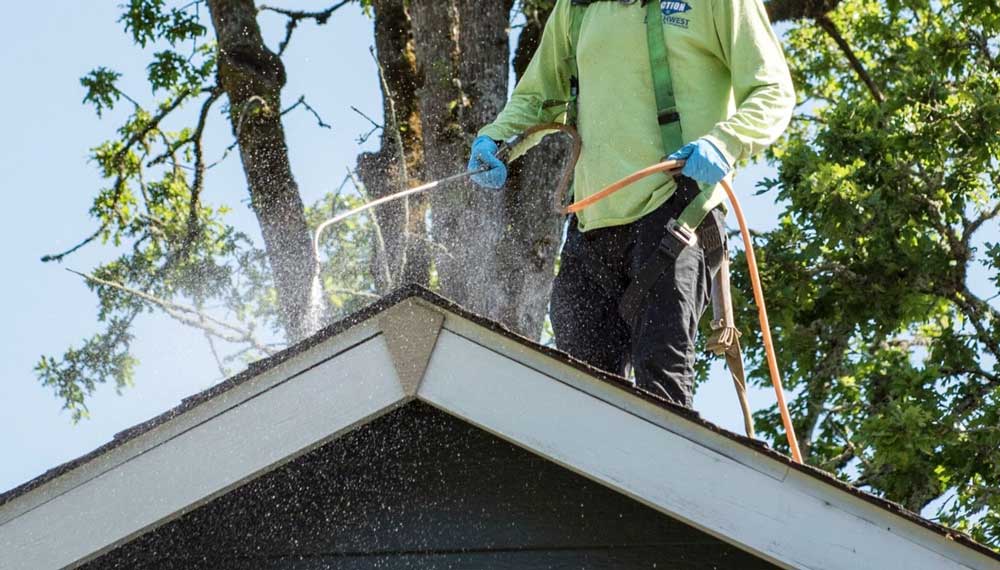
In order for moss to thrive, it needs to be provided with a damp environment, which is why it tends to be most commonly found in forests, swamps, and other wet areas, where moisture builds and cannot escape. And while there’s no denying how attractive certain types of moss can be, it’s always an unwelcome sight when it begins to accumulate on your roof.
Though a highly common problem, roof moss should be addressed with a sense of urgency. Whichever roof moss treatment method you decide on, it’s a good idea to get to work on it as quickly as possible. It will need to be removed and killed with treatment, before preventative steps can be taken to ensure it doesn’t make a comeback.
Why Roof Moss Should Be Removed
Even if you think it adds a welcome aesthetic lift to your home (and others might differ), roof moss can cause serious damage. The most common problem associated with moss is the very slow but continuous lifting of the roof shingles, which happens when moss creeps under the shingles and continues its expansion. When this occurs, the roof (in whole or in part) is no longer able to provide full protection from the elements. Rain finds its way into the woodwork of your roof and eventually leads to rot. In addition, a strong gust of wind could easily catch the lifted shingles and tear them straight off the roof. Over time, moss can also directly begin breaking down the integrity of the shingles themselves, reducing their ability to protect your home.
Killing Roof Moss
Treat It
Once moss is removed from your roof, your roof should be treated with an EPA approved moss killer. Thereafter, preventative moss treatment on a regular schedule based on your roof is always the best course of action. This approach has the advantage of being easiest on your roof. If you see green, it’s past time to treat.
If you are going to attempt to treat your roof for moss yourself, be sure to follow all label instructions (it’s the law). Make sure to follow the recommendations for protective clothing and equipment (this stuff can make you really sick), and make sure you are absolutely safe by using proper ladders, ropes and harnesses while you are on the roof.
Purpose Made Moss Killer, Applied by Professionals
The best solution is to have expert Oregon Department of Agriculture-licensed professionals, with proper protective clothing and equipment, use the proper methods to apply the proper amount of moss treatment that is specifically designed and approved by the EPA for treating moss on roofs. If you are going to DIY, you should not do anything less–or more.
DIY Remedies
As the homeowner, you personally can put whatever you want to on your roof. Anything which radically changes the ph of the moss will probably kill it–or at least make feel like it is having a bad day. However, if you hire anyone, even your nephew, or the neighbors’ kid to put moss killer on your roof, they MUST be licensed by the Oregon Department of Agriculture and they must use only EPA approved and labeled products. Since we are ODA licensed, we really don’t know whether DIY remedies work, or not. We don’t use them. What we use works, is safe if handled properly, and complies with all aspects of the law.
Zinc Strips
Zinc strips do not work as an effective moss deterrent. Even the literature promoting them indicates that they are effective for only about 10 feet below the strip–in the best of conditions. And even the smallest roofs are usually at least 17 feet from ridge cap to eave. Why don’t they work? They aren’t big enough to provide enough zinc to leach off and prevent moss growth. If they were about a foot wide, they would probably work great. But would you want a foot wide metal strip across your roof? Maybe you could start a new fashion
Commercial Weed Killer
Don’t do this. Please. If you don’t care about pets or the environment, please think of the children! Commercial weed killer is designed to kill complex plants and is way too powerful and dangerous to apply to your roof. It is massive overkill, and probably illegal if the label does not specifically say that it is appropriate for roofs.
New Shingles?
Maybe you have ignored the problem for years, and now your 30 year roof is a complete moss-covered disaster, and has prematurely failed. So now you need a new roof. It probably won’t make you feel any better to know that you are now going to pay about two hundred times (200x) the cost of one professional moss treatment to replace your roof, which probably should have lasted another decade or two.
But if things haven’t gone that far, it may make you feel better to know that you can probably get at least that decade or two out of your roof by spending less than half of one percent of the cost of a new roof every year to keep the one you have. We would suggest that is a pretty good value proposition.
Let our expert, licensed, insured, crews take care of the moss on your roof. For a free estimate, click the button or give us a call at (503) 407-3346.